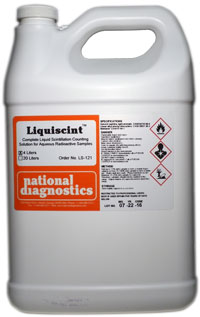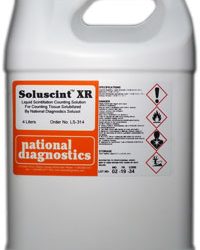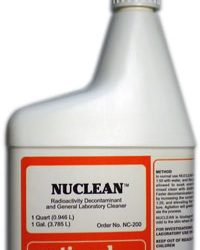Liquid Scintillation
Liquiscint
$136.00 – $534.00
Quantity discount when you buy 4 or more 4 liter bottles!
Catalog Number: LS-121
- Economical Traditional Formulation
- Solid Consistent Performer
- High Flash Point Low Evaporation Rate Solvent
Description
Quantity discount when you buy 4 or more 4 liter bottles!
Catalog Number: LS-121
- Economical Traditional Formulation
- Solid Consistent Performer
- High Flash Point Low Evaporation Rate Solvent
Liquiscint is an economical, ready-to-use liquid scintillation solution designed for aqueous and organic samples. Liquiscint is intended as a general replacement for toluene-Triton X-100 LSC solutions.
For no more than you are now paying to prepare your own solutions, Liquiscint offers the advantages of convenience and safety, as well as stringent quality control testing to ensure consistency from batch to batch.
Liquiscint is manufactured using our exclusive high flash point, low evaporation rate solvent which offers higher counting efficiency while also reducing fire hazard and exposure to aromatic solvents.
Storage: Liquiscint is best stored tightly capped in a cool, dry area. It is stable for five years under normal conditions. Flash point 114oF (TCC).
Additional information
| Weight | 9 lbs |
|---|---|
| Dimensions | 15 × 10 × 13 in |
Safety Overview
Safety Summary (see SDS for complete information before using product):
Appearance and odor:
Clear liquid with blue phosphoresence and mild odor
Flammable. Harmful if swallowed.
Keep out of reach of children. Do not breathe fumes. Avoid contact with the skin. If swallowed, do not induce vomiting. Seek medical advice immediately and show this container or label.
EMERGENCY OVERVIEW – IMMEDIATE HAZARD
Solvent Naphtha, Light Aromatic
POISON! DANGER! UNDILUTED COMPONENTS CAUSE BURNS TO ANY AREA OF CONTACT. MAY BE FATAL IF SWALLOWED. HARMFUL IF INHALED. CONTACT WITH OTHER MATERIALS MAY CAUSE FIRE.
Methanol
WARNING! HARMFUL OR FATAL
- Waste Disposal Issues in Scintillation Counting
- The Complete Scintillation Cocktail
- Radioactive Emissions and the Use of Isotopes in Research
- Preparing Tissue Samples for Scintillation Counting
- Preparing Samples in PAGE Gels for LSC
- Mechanism of Liquid Scintillation Counting
- Measurement of Radiation and Isotope Quantitation
- Liquid Scintillation Signal Interpretation
- Liquid Scintillation and Radiation Safety
- HPLC Flow Counting
- Counting Samples on Cellulose-Ester Filters
- Counting Samples from TLC Plates by LSC
- Counting Efficiency and Quenching
- Counting Carbon Dioxide by LSC
- Chemiluminescence and Static Electricity
- Assaying Discrete Samples by Liquid Scintillation Counting




